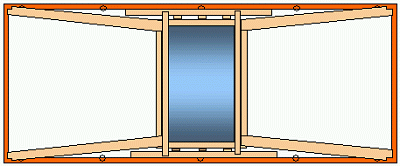The residual longitudinal securing effort of 17 · 0.7 · 9.81 = 117 kN is achieved by lashings and by pressure elements to the end walls and corner posts. The pressure elements consist of two timbers of 15 x 15 cm cross-section, secured against falling loose and against buckling due to their length. Only four of the securing points bear simultaneously to fore or aft. The lashings also have a transverse effect.
The residual transverse securing effort of 17 · 0.4 · 9.81 = 67 kN is achieved by lashings and by pressure elements to each side. Only three securing points are loaded simultaneously. However, due to the unfavourable lashing angles only two points are considered in the transverse balance.

Figure 32: Longitudinal and transverse lashing of the coil

Figure 33: Longitudinal and transverse shoring of the coil
The arrangement is checked by a balance:
| Longitudinally: | 1 · 9.81 · 17 ≤ 0.3 · 17 · 9.81 + (4 · 10 + 2 · 225 · 0.3) / 1.5 |
| 167 ≤ 50 + 117 |
| 167 = 167 | Balance is just met! |
| Transversely: | 0.8 · 9.81 · 17 ≤ 0.4 · 17 · 9.81 + (2 · 10 + 3 · 100 · 0.3) / 1.5 |
| 133 ≤ 67 + 173 |
| 133 < 140 | Balance is just met! |
The securing effort is less than in the previous example. The quality however, is even more important due to the increased mass of the coil. Due to the marginal satisfaction of the balances, good workmanship is of particular concern.